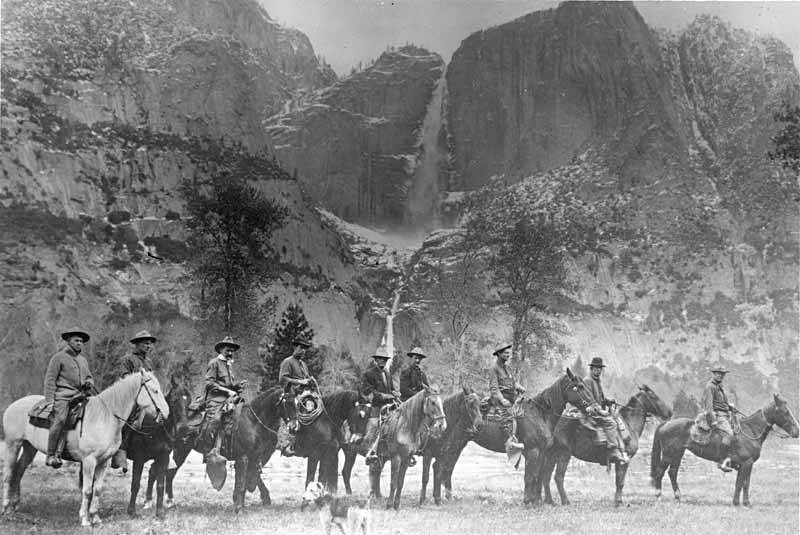
NPS Collections. This article was first published in the 2017 Highlights of ISB (annual report), and was written by Assistant Special Agent in Charge (retired) Jeff Sullivan and Special Agent in Charge (retired) Scott Hinson.
With the hiring of a law enforcement specialist stationed at Yosemite National Park in the mid 1960s, the National Park Service (NPS) laid the foundation for a dedicated work unit with the sole purpose of law enforcement and investigations. Populations living near the national parks were steadily growing, and park visitation was rapidly increasing. Rangers of the time knew that officers were needed who could dedicate more time and specialize in complex investigations. US Park Rangers are a true icon, wearing many hats and for many years serving as “generalists.” They rapidly shift from law enforcement to emergency medical services, fire suppression to search and rescue, and visitor services to resource education throughout their workdays. Over the years the NPS has made several attempts to dedicate personnel solely to criminal investigations. The myriad duties of the US Park Ranger are all critically needed functions. A ranger’s skill set must be kept up every day; opportunities to dedicate extended time for criminal investigations are necessarily limited. This is where the dedicated investigation operation provides the most benefit to our national parks. Criminal investigators have the time and experience to take those crimes that rangers initially investigate and carry them onward to successful resolution through prosecutions and adjudications. Civil settlements and the documentation of criminal incidents likewise have value as part of the park system’s historical and operational records. In 1976 Yosemite National Park and Olympic National Park started the first offices within their Ranger Divisions that were solely dedicated to criminal investigations. A Chief Criminal Investigator and two investigators were stationed at Yosemite, while Olympic began with just one investigator. Other parks, noting the success of those operations, soon followed suit. Yosemite National Park also employed the first female and American Indian criminal investigators in the NPS. The Office of Inspector General (OIG) of the US Department of the Interior (DOI) released a report in March 2002 concerning DOI law enforcement operations. Secretary of the Interior Gale Norton directed the department’s bureaus to address issues identified in that report with a series of law enforcement reforms. One of those reforms brought about the placement of all criminal investigators in the National Park Service into a single line of authority. Accounts vary as to how many criminal investigators the NPS had going into the early 2000s; a safe estimate puts the number at 60-65 stationed at various parks, regional offices, and the Federal Law Enforcement Training Center. In April 2003, those investigators moved from the supervision of specific parks to an office created within the Washington Support Office (WASO). This office is now known as the Investigative Services Branch (ISB). As with any changes in a large government agency, the new line authority was a difficult adjustment at times. Many NPS managers were upset or had concern that local parks would lose control over what investigators did in their parks. Funding for the criminal investigators’ positions was also shifted from the parks to WASO. But the change also brought relief. One immediate benefit of the line authority change was the ability to provide investigative support to those parks without dedicated investigators. Initially the new ISB was headed by a national Special Agent in Charge (SAC). Six other SACs oversaw investigations in each of the NPS regions. As budgets became tighter and the need to place more investigators in the field became more apparent, the command structure for the branch was pared down to three SACs with two Assistant Special Agents in Charge (ASAC) reporting to each SAC. This model divided the country into three areas of responsibility: East, Central, and West. Further reductions in budget, increases in operational costs, and staffing the NPS Office of Professional Responsibility left a loss in not only supervisors but in field investigators, too. Today, ISB operates with approximately half the number of criminal investigators as it had at its inception. The Chief, SAC, and five ASACs lead ISB. Investigators are stationed throughout the National Park System across four field offices. Despite shrinking resources, ISB found a true force multiplier with the addition of two program specialist personnel positions and an Intelligence Analyst. Their work frees up a great amount of time for Special Agents in the field - a vitally necessary component given the current lean staffing level. ISB is in the Associate Directorate of Visitor and Resource Protection and is a branch of the Division of Law Enforcement, Security, and Emergency Services.
Explore ISB |
Last updated: November 29, 2021
